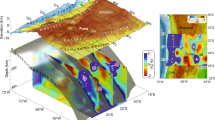Abstract
Images obtained by the Voyager spacecraft revealed dark, wedge-shaped bands on Europa that were interpreted as evidence that surface plates, 50–100 km across, moved and rotated relative to each other1. This implied that they may be mechanically decoupled from the interior by a layer of warm ice or liquid water2,3. Here we report similar features seen in higher resolution images (420 metres per pixel) obtained by the Galileo spacecraft that reveal new details of wedge-band formation. In particular, the interior of one dark band shows bilateral symmetry of parallel lineaments and pit complexes which indicates that plate separation occurred in discrete episodes from a central axis. The images also show that this style of tectonic activity involved plates < 10 km across. Although this tectonic style superficially resembles aspects of similar activity on Earth, such as sea-floor spreading and the formation of ice leads in polar seas, there are significant differences in the underlying physical mechanisms: thewedge-shaped bands on Europa most probably formed when lower material (ice or water) rose to fill the fractures that widened in response to regional surface stresses.



Similar content being viewed by others
References
Schenk, P. M. & Seyfert, C. K. Fault offsets and proposed plate motions for Europa. Eos 61, 286 (1980).
Schenk, P. M. & McKinnon, W. B. Fault offsets and lateral crustal movement on Europa: Evidence for a mobile ice shell. Icarus 79, 75–100 (1989).
Golombek, M. P. & Banerdt, W. B. Constraints on the subsurface structure of Europa. Icarus 83, 441–452 (1990).
Belton, M. J. S.et al . Galileo's first images of Jupiter and the Galilean satellites. Science 274, 377–385 (1996).
Tufts, B. R., Greenberg, R., Sullivan, R., Pappalardo, R. & the Galileo Imaging Team Reconstruction of Europan terrain in the Galileo C3 “wedges” image and its geological implications. Lunar Planet. Sci. Conf. XXVIII, 1455– 1456 (1997).
Carr, M. H.et al. Evidence for a subsurface ocean on Europa. Nature 391, 363–365 ( 1998).
Pappalardo, R. T.et al . Morphological evidence for solid-state convection in Europa's ice shell. Nature 391, 365– 368 (1998).
Fanale, F. P., Johnson, T. V. & Matson, D. L. in Planetary Satellites (ed. Burns, J. A.) 379–405 (Univ. Arizona Press, Tucson, 1977).
Squyres, S. W., Reynolds, R. T., Cassen, P. M. & Peale, S. J. Liquid water and active resurfacing on Europa. Nature 301, 225–226 (1983).
Anderson, J. D., Lau, E. L., Sjogren, W. L., Schubert, G. & Moore, W. B. Europa's differentiated internal structure: Inferences from two Galileo encounters. Science 276, 1236–1239 (1997).
Tufts, B. R. Photogeological analysis of Europan tectonic features. Lunar Planet Sci. Conf. XXIV, 1445–1446 (1993).
Tufts, B. R. ASan Andreas-sized strike-slip fault on Europa. Lunar Planet Sci. Conf. XXVII, 1343–1344 ( 1996).
Pappalardo, R. T. & Sullivan, R. Evidence for separation across a gray band on Europa. Icarus 123 , 557–567 (1996).
Acknowledgements
We thank N. Sleep for reviews, and K. Klaasen, H. Breneman, T. Jones, J. Kaufman, K. Magee and D. Senske at JPL for their efforts. Cooperation from personnel responsible for other instruments after a playback anomaly on Galileo's third orbit allowed recovery of the high-resolution image shown in Figs 2 and 3. This work was supported by NASA's Galileo Project.
Author information
Authors and Affiliations
Corresponding author
Rights and permissions
About this article
Cite this article
Sullivan, R., Greeley, R., Homan, K. et al. Episodic plate separation and fracture infill on the surface of Europa . Nature 391, 371–373 (1998). https://doi.org/10.1038/34874
Received:
Accepted:
Issue Date:
DOI: https://doi.org/10.1038/34874
- Springer Nature Limited
This article is cited by
-
Double ridge formation over shallow water sills on Jupiter’s moon Europa
Nature Communications (2022)
-
Ice-Ocean Exchange Processes in the Jovian and Saturnian Satellites
Space Science Reviews (2020)





